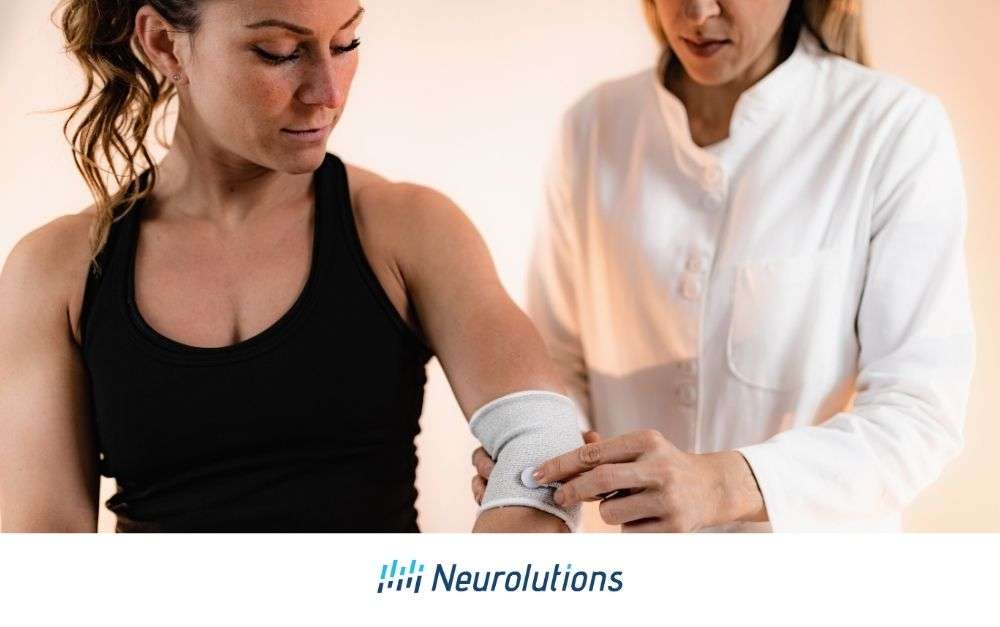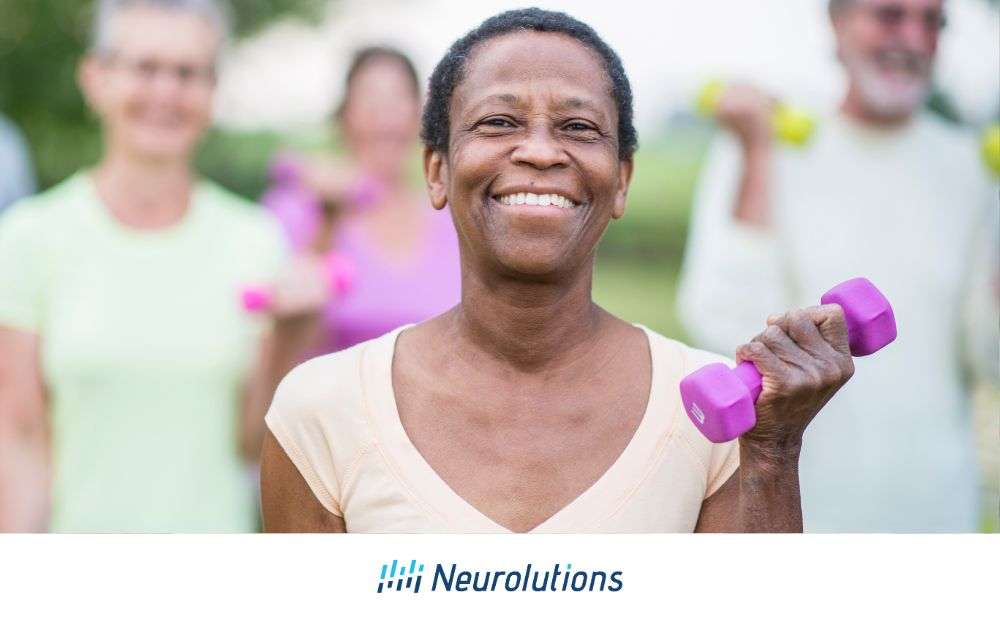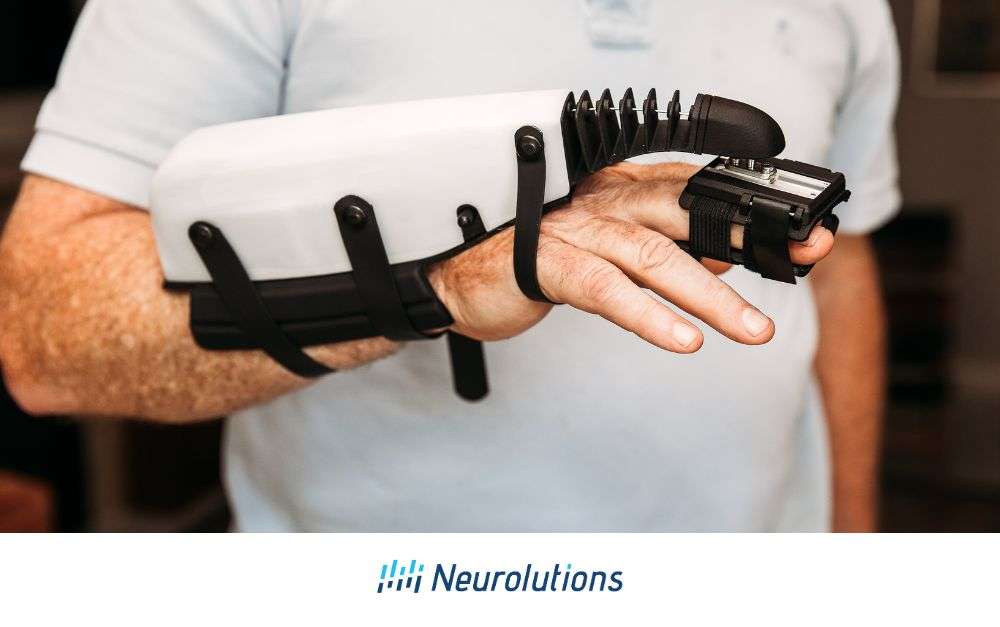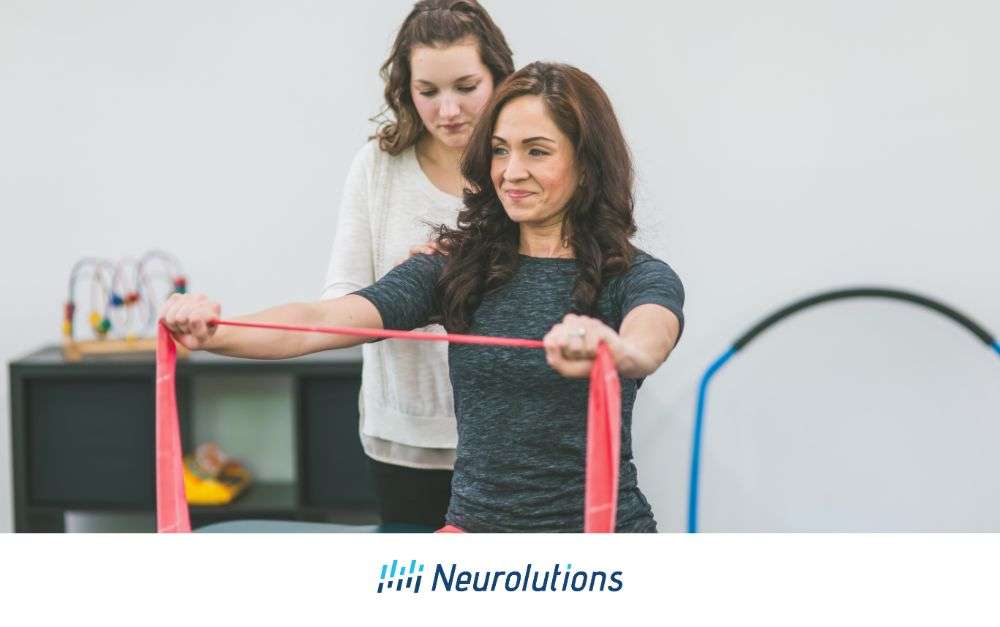Transcutaneous Electrical Nerve Stimulation (TENS) is widely used in pain treatment, but it is also a tool that physical and occupational therapists may employ as a strategy to help stroke survivors recover their motor skills. (1). This small machine generates an electrical current which is transferred to the person receiving the treatment through electrodes placed on their skin. The current stimulates the nerves in that area of the body to signal nearby muscles to contract. Using this strategy, TENS therapy can be used to both prevent muscle atrophy (wasting and thinning) and spasticity and promote overall neural network healing (2).
Certain TENS machines can be purchased online or in a health store without a prescription, and it is possible for the patient to use it at home without supervision of a therapist. The following describes why and how TENS machines as well as three other types of electrical stimulation are used to boost recovery in the rehab of stroke survivors.
How TENS Machines and Electrical Stimulation Aid in Stroke Recovery
Brain injuries occur during a stroke due to the damage to nerves, brain cells, and brain tissue caused by a blood clot or bleeding in the brain. The lack of oxygen to the brain causes damage that in turn may cause weakness in the arm, leg, or other parts of the body.
Depending upon the hemisphere of the brain injury (left side or right side), the individual can experience paralysis or weakness affecting the opposite side of the body, along with other impacts. Around 80% of all stroke survivors experience limb paralysis or weakness, therefore experiencing a negative impact on their movement abilities (3). Of these, 70% experience arm weakness, and 62% of those survivors have not regained arm dexterity at six months after the stroke (4).
The objective of electrical stimulation (ES)–including the use of a TENS machine–is to enable motor skill recovery such as the ability to utilize arms, hands, and fingers, or even walk. Without the interventions of a physical and/or occupational therapist, paralysis, or weakness in the arm and leg can persist. This weakness can interfere with the performance of activities of daily living (ADLs) and diminishing independence.
Muscle “re-education” addressing paralysis and spasticity is a significant focus of stroke rehabilitation so that muscles can learn to work together seamlessly in muscle groups to perform normal movements. Passive and active exercises focused on each muscle group are utilized in physical and/or occupational therapy while massage, electrical stimulation, hot/cold applications, and other methods may also expedite recovery. In addition, exercises aimed at improving eye-hand coordination, repetitive practice of tasks involved in cognitive skill-boosting, and mirroring of correct movements to perform an ADL task are also employed by therapists to improve overall motor skills.
Importantly, physical and/or occupational therapists may use electrical stimulation (including TENS) as part of stroke rehab with intentions to:
- Decrease pain upon movement, and thereby prevent muscle atrophy
- Decrease muscle spasticity (involuntary, erratic, and incorrect muscle movements)
- Promote increased and correct nerve signaling to muscle groups, plus growth of new neural pathways and brain nerve cells
- Improve muscle tone, strength, and functioning
- Facilitate normal movement ability necessary for performing customary ADLs
- Boost the brain’s “neuroplasticity” to speed up recovery
Muscle Re-Education: Regaining Control and Strength
Electrical activity as a result of electrical impulses are necessary for muscles to receive nerve-transmitted “messages” to voluntarily contract and relax as required for movement. Muscle mass, muscle strength, and muscle control can be improved through certain types of electrical stimulation including TENS (5). Likewise, research findings showed that TENS improved spasticity, muscle strength, and muscle functioning in stroke survivors (6). In stroke patients, electrical stimulation is primarily utilized while engaged in physical and/or occupational therapy to improve muscle flexibility, strength, and functioning.
Three other modes of electrical stimulation besides TENS used in stroke survivors are:
- Neuromuscular electrical stimulation (NMES) – Electrode pads are placed onto the skin above targeted muscles. Through these electrode pads, an electrical current stimulates the muscles encouraging movement. NMES is generally utilized for muscle strengthening, maintenance of muscle mass, and control of lower limb edema resulting from prolonged immobility.
- Functional Electrical Stimulation (FES) – This treatment is a subtype of NMES (7). It involves incorporating the use of NMES into a functional activity. FES is often used to treat “foot-drop”, in which the front part of the foot drags; this is a common side-effect of stroke.
- Interferential Current (IFC) – This treatment uses a medium frequency with alternating currents and is applied transcutaneously with electrode pads (8). It is focused on reduced cutaneous nerve stimulation with maximization of deep tissue effects. It is used primarily for pain reduction, as well as reduction of lower limb edema.
Unlike the other electrical stimulation modes, TENS and NMES are the only methods that may be used by patients by themselves at home following proper training and education.
Pain Management in Stroke Survivors: Alleviating Discomfort & Improving Quality of Life
Pain is common in stroke survivors, and four types are especially associated with the specific effects of a stroke (9):
- Central Post-Stroke Pain (CPS): This is neuropathic pain that is characterized by both decreased sensations and hypersensitivity in the body areas corresponding to the brain location of the stroke-caused brain injuries (10).
- Complex Regional Pain Syndrome (CRPS): This is chronic pain affecting the limbs and can include swelling of the limb as well as changed temperature/color of the skin.
- Pain associated with muscle spasticity: As paralysis or weakness after a stroke subsides and the ability to move muscle groups increases, muscle spasticity may also occur. The involuntary muscle contractions and muscle spasms due to spasticity can be painful.
- Pain associated with shoulder subluxation: This is dislocation of the shoulder joint due to nearby muscle weakness, and is a common stroke complication that occurs in up to 84% of all survivors after a moderate-to-severe stroke (11).
In patients recovering from ischemic strokes, at least 10% experience chronic post-stroke pain that does not disappear over time (9). Therefore, pain management is a vital aspect of treating stroke survivors.
The use of TENS units has been found to dull pain, which is important for physical and/or occupational therapists working with stroke patients on exercises to recover motor skills (12). The strength of the electrical current can be modulated to a level that is the most effective in relieving the stroke patient’s pain. TENS units can also be purchased “over-the-counter” at most chain pharmacies; these are typically smaller units with a lower electrical charge threshold than those in rehab environments. Use of the TENS unit is typically limited to once each day for a maximum of 10-15 minutes in order to prevent burning or damaging the skin.
Motor Recovery: Restoring Movement and Functionality
Stroke-caused paralysis and weakness can significantly impede motor skill recovery to perform normal daily activities. Physical and/or occupational therapy can promote the highest level of restored motor skills and functionality if it commences quickly following a stroke, as the majority of progress in recovering motor skills occurs during the early post-stroke period (13). Importantly, the reduction of pain through the use of electrical stimulation and other methods may allow the stroke survivor to more fully engage in the therapeutic exercises needed to regain lost motor skills and function independently in performing their normal ADL.
This improved level of motor skill functioning is also associated with decreased overall depression and anxiety as well as an improved quality of life.
Choosing the Right TENS Machine or Electrical Stimulation Device
The “right” electrical stimulation device (including TENS machines) depends upon the aim of its use in the specific stroke survivor. It’s also crucial for individuals, especially stroke survivors, to consider several factors before using a Transcutaneous Electrical Nerve Stimulation (TENS) device at home.
Here are some considerations:
Consultation with healthcare professionals: Before purchasing an electrical stimulation device, it’s essential to consult with healthcare professionals, such as physical therapists, occupational therapists, or physicians. They can assess whether TENS is appropriate for your specific condition, guide you on proper usage, and recommend appropriate settings. They may also determine a different therapeutic technology or treatment would be more appropriate for making gains in function.
Understanding the condition: Different strokes can result in a variety of physical conditions, and the suitability of TENS and electrical stimulation therapy can vary. Understanding your specific condition, its symptoms, and how TENS might help is important. Discuss your medical history and any potential contraindications with your healthcare provider.
Precautions: Be aware of contraindications and precautions associated with TENS use. For example, individuals with pacemakers, certain types of heart conditions, or skin sensitivities may need to avoid TENS therapy. Stimulation should not be used over swollen, red, infected or inflamed skin (14). Your healthcare provider can help determine if there are any specific concerns related to your health.
Adjustability: Look for a device that is adjustable and allows you to control the intensity and frequency of the electrical stimulation. This flexibility is important to tailor the treatment to your specific needs and comfort level.
Tips and Precautions when Using TENS Machines or Electrical Stimulation Devices at Home
Proper training on a TENS machine or electrical stimulation device is important. Trained rehabilitation therapists should provide education and guidance on electrode placement, intensity settings, and duration of use. Although some devices can be purchased over-the-counter and without a prescription, it is often necessary to have a healthcare professional supervise initial use and guidelines for safety and to monitor response.
Always follow the manufacturer’s instructions. Each device will have specific guidelines regarding usage, maintenance, and safety precautions that should be strictly followed.
Pay attention to how your body responds to electrical stimulation therapy. If you experience any adverse effects, discomfort, or changes in your condition, discontinue use and consult with your healthcare provider.
If you choose to use a TENS device at home, schedule regular check-ins to monitor progress and make any necessary adjustments to your treatment plan.
What the Literature says about TENS and other types of Electrical Stimulation Devices
Evidence-Based Review of Stroke Rehabilitation (2020) provides the following conclusions summarizing the best-evidence available on TENS and other forms of electrical stimulation devices. Note that different conclusions are available for both Upper Extremity and Lower Extremity. Consult EBRSR for further study highlights and details (15).
Upper Extremity:
- TENS:
- TENS may be beneficial for improving motor function, but the evidence is mixed regarding improvement in dexterity, ADLs (activities of daily living) and muscle strength.
- Cyclic NMES: NMES timed on a cycle while the individual attempts to move with the aid of the stimulation
- May be beneficial for improving motor function but not ADLs and muscle strength. The literature is mixed regarding improvements in spasticity and range of motion.
- EMG triggered NMES: NMES that activates once the system recognizes the a muscle has been volitionally activated to a set threshold
- May be beneficial for improving dexterity, spasticity and range of motion, but not motor function and muscle strength. The literature is mixed regarding improvements in ADLs.
- FES: electrical stimulation that accompanies task-based activities, i.e. functional electrical stimulation
- May be beneficial for improving dexterity, but not muscle strength. The literature is mixed regarding improvements in motor function, ADLs, spasticity, range of motion and stroke severity.
Lower Extremity
- TENS
- TENS may be beneficial for improving functional mobility, functional ambulation, range of motion and spasticity. The literature is mixed regarding TENS for improving motor function, activities of daily living, gait, balance, and muscle strength.
- FES and FES-Based Orthosis for Gait Cycle:
- Functional electrical stimulation may be a suitable adjunct for therapies targeting lower limb motor function post stroke.
- FES has been shown to improve ADLs, muscle strength, functional ambulation and gait. It may help motor function and spasticity but does not improve balance and functional mobility more than conventional care.
- NMES: A technique used for generating muscle contractions in the muscles in the lower extremity
- NMES may be beneficial for functional mobility and muscle strength. The literature is mixed for NMES regarding its improvement to functional ambulation, balance, spasticity, range of motion, stroke severity and activities of daily living. NMES may not be beneficial for improving motor function or gait.
While there may be benefits for use of TENS and other forms of electrical stimulation, it is important for stroke survivors to work closely with rehabilitation professionals before determining if and when they should be utilized in a motor recovery program after a stroke. A comprehensive and individually tailored program should always consider utilizing evidence-based, technology assisted rehabilitation options to enable stroke survivors with impaired motor skills return as close as possible to their daily activities and better quality of life.
References:
- Johnson MI, Paley CA, Jones G, et al. (2022). Efficacy and safety of transcutaneous electrical nerve stimulation (TENS) for acute and chronic pain in adults: A systematic review and meta-analysis of 381 studies (the meta-TENS study). BMJ Open 12: e051073. Webpage: https://bmjopen.bmj.com/content/12/2/e051073
- In, Tae-Sung, et al. “Effectiveness of Transcutaneous Electrical Nerve Stimulation with Taping for Stroke Rehabilitation.” BioMed Research International, vol. 2021, Aug. 2021, p. 9912094. Webpage: https://www.ncbi.nlm.nih.gov/pmc/articles/PMC8410308/
- Stroke Association. (June 2013). Physical effects of stroke. Webpage: https://www.stroke.org.uk/sites/default/files/physical_effects_of_stroke.pdf
- Allison R, Shenton L, Bamforth K, et al. (2016). Incidence, Time Course and Predictors of Impairments Relating to Caring for the Profoundly Affected arm After Stroke: A Systematic Review. Physiotherapy Research International 21(4): 210-227. Webpage: https://www.ncbi.nlm.nih.gov/pmc/articles/PMC5157782/
- Enoka RM, Amiridis IG, and Duchateau J. (2020). Electrical Stimulation of Muscle: Electrophysiology and Rehabilitation. Physiology 35(1): 40-56. [Published online in 2019]. Webpage: https://journals.physiology.org/doi/full/10.1152/physiol.00015.2019
- Ng SSM, and Hui-Chan CWY. (2007). Transcutaneous Electrical Nerve Stimulation Combined With Task-Related Training Improves Lower Limb Functions in Subjects With Chronic Stroke. Stroke 38(11): 2953-2959. Webpage: https://www.ahajournals.org/doi/10.1161/strokeaha.107.490318
- Marquez-Chin C, and Popovic MR. (2020). Functional electrical stimulation therapy for restoration of motor function after spinal cord injury and stroke: A review. Biomedical Engineering OnLine19(34). (Open access). Webpage: https://www.ncbi.nlm.nih.gov/pmc/articles/PMC7245767/
- Rampazo ÉP, and Liebano RE. (2022). Analgesic Effects of Interferential Current Therapy: A Narrative Review. Medicina (Kaunas) 58(1) :141. Webpage: https://www.ncbi.nlm.nih.gov/pmc/articles/PMC8779694/
- Treister AK, Hatch MN, Cramer SC, et al. (2017). Demystifying Poststroke Pain: From Etiology to Treatment. PM R. 9(1): 63-75. [official journal of the American Academy of Physical Medicine and Rehabilitation(AAPM&R)]. Webpage: https://www.ncbi.nlm.nih.gov/pmc/articles/PMC5161714/
- Klit H, Finnerup NB, and Jensen TS. (2009). Central post-stroke pain: Clinical characteristics, pathophysiology, and management. Lancet Neurology 8(9): 857-68. Webpage: https://pubmed.ncbi.nlm.nih.gov/19679277/
- American Stroke Association. Questions about Shoulder Pain. Webpage: https://www.stroke.org/en/about-stroke/effects-of-stroke/physical-effects-of-stroke/managing-pain/questions-about-shoulder-pain#:~:text=As%20many%20as%2084%20percent,less%20than%20one%2Dfinger%20width.
- Vance CGT, Dailey DL, Chimenti RL, et al. (2022). Using TENS for Pain Control: Update on the State of the Evidence. Medicina 58(10): 1332. (Open access). Webpage: https://www.mdpi.com/1648-9144/58/10/1332
- National Institutes of Health (NIH). (September 28, 2021). Critical time window for rehabilitation after a stroke. Webpage: https://www.nih.gov/news-events/nih-research-matters/critical-time-window-rehabilitation-after-stroke
- University of Iowa Hospitals and Clinics. (Last updated January 2019). Transcutaneous electrical nerve stimulator (TENS). Webpage: https://uihc.org/health-topics/transcutaneous-electrical-nerve-stimulator-tens
- Evidence-Based Review of Stroke Rehabilitation (2020): http://www.ebrsr.com





